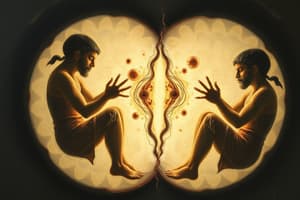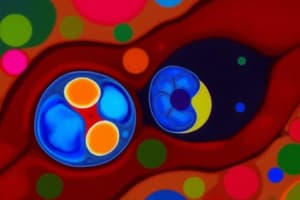Podcast
Questions and Answers
What is the main aim of spermatogenesis?
What is the main aim of spermatogenesis?
- To increase the number of chromosomes
- To form mature male gametes with half the chromosome number (correct)
- To change the shape of female gametes
- To facilitate cell division in somatic cells
Meiosis results in cells that contain the same number of chromosomes as the parent germ cell.
Meiosis results in cells that contain the same number of chromosomes as the parent germ cell.
False (B)
What process describes the formation of female gametes?
What process describes the formation of female gametes?
Oogenesis
The process of spermatogenesis occurs in the __________ of the male gonads.
The process of spermatogenesis occurs in the __________ of the male gonads.
During which stage of spermatogenesis does the primary spermatocyte divide?
During which stage of spermatogenesis does the primary spermatocyte divide?
Each secondary spermatocyte divides to form four spermatids.
Each secondary spermatocyte divides to form four spermatids.
How many chromosomes do secondary spermatocytes contain?
How many chromosomes do secondary spermatocytes contain?
The terminal piece of the sperm is part of the __________.
The terminal piece of the sperm is part of the __________.
Match the following stages of spermatogenesis with their descriptions:
Match the following stages of spermatogenesis with their descriptions:
What type of cell division occurs during the proliferation stage of spermatocytogenesis?
What type of cell division occurs during the proliferation stage of spermatocytogenesis?
Which of the following describes azospermia?
Which of the following describes azospermia?
Oligospermia refers to the presence of many sperms in the semen.
Oligospermia refers to the presence of many sperms in the semen.
What is the process of production of a mature ovum called?
What is the process of production of a mature ovum called?
The __________ is the structure that surrounds each primary oocyte.
The __________ is the structure that surrounds each primary oocyte.
Match the sperm abnormalities with their descriptions:
Match the sperm abnormalities with their descriptions:
What marks the end of fetal life in oogenesis?
What marks the end of fetal life in oogenesis?
Each primary oocyte undergoes two meiotic divisions during the maturation stage.
Each primary oocyte undergoes two meiotic divisions during the maturation stage.
What type of cells do primary oocytes start to divide into during the prenatal development stage?
What type of cells do primary oocytes start to divide into during the prenatal development stage?
Sperms that are dead are referred to as __________.
Sperms that are dead are referred to as __________.
During which stage of oogenesis do the follicular cells begin to enlarge and become cubical?
During which stage of oogenesis do the follicular cells begin to enlarge and become cubical?
Study Notes
Cell Division
- Mitosis is the process by which a germ cell containing 46 chromosomes divides into two cells, each with 46 chromosomes (22 autosomes + 2 sex chromosomes).
- Meiosis involves a germ cell containing 46 chromosomes dividing into two cells, each having 23 chromosomes (22 autosomes + 1 sex chromosome).
Gametogenesis
- Definition: The formation of mature male gametes (spermatogenesis) and mature female gametes (oogenesis) from immature germ cells within the gonads.
- Spermatogenesis occurs in the seminiferous tubules of the testis, reducing the chromosome count from 46 to 23 and altering the shape of the male germ cell for fertilization.
- Oogenesis is the process of producing a mature ovum in the cortex of the ovary, beginning during fetal development and continuing after puberty during each ovarian cycle, as well as after fertilization.
- Oogenesis reduces the chromosome count from 46 to 23 and increases the size of the ovum from 30 µ to 120 µ.
Spermatogenesis
- Stages:
- Spermatocytogenesis:
- Stage of proliferation: Spermatogonia undergo mitosis, creating two daughter spermatogonia, each with 46 chromosomes.
- Stage of growth: Daughter spermatogonia enlarge into primary spermatocytes containing 46 chromosomes.
- Stage of maturation:
- Meiosis: Primary spermatocytes divide through meiosis, resulting in two secondary spermatocytes.
- Equational division: Each secondary spermatocyte divides (similar to mitosis) into two spermatids, containing the same number of chromosomes as the secondary spermatocytes.
- Spermiogenesis: The spermatid undergoes transformation into a motile sperm.
- Spermatocytogenesis:
Sperm Structure
- Head: Contains the condensed nucleus covered by an acrosomal cap on the anterior 2/3.
- Neck: A constriction behind the head, containing two centrioles.
- Body (middle piece): Composed of the plasma membrane, mitochondrial sheath, and nine bundles of microfilaments.
- Tail:
- Principle piece:
- Terminal piece:
Sperm Abnormalities
- In Form:
- Giants (too large)
- Dwarfs (too small)
- Bicephalic (two heads)
- Bicaudal (two tails)
- In Number:
- Azospermia: Absence of sperms in semen.
- Oligospermia: Presence of few sperms.
- Necrospermia: Presence of dead sperms.
Oogenesis
- Prenatal Development:
- Stage of proliferation: The fetal ovary contains oogonia, which divide by mitosis to form two daughter oogonia, each with 46 chromosomes.
- Stage of growth: The majority of oogonia degenerate, while the surviving ones enlarge into primary oocytes (46 chromosomes). Each primary oocyte is surrounded by a layer of flat epithelial cells called follicular cells, forming a primordial follicle.
- Postnatal (After Puberty):
- Stage of maturation:
- Meiosis: Each primary oocyte undergoes the first meiotic division, forming:
- First polar body (22 + X): A small cell with minimal cytoplasm.
- Secondary oocyte (22 + X): A large cell containing most of the cytoplasm.
- Equational division: The secondary oocyte undergoes the second meiotic division, yielding:
- Second polar body
- Ovum
- Meiosis: Each primary oocyte undergoes the first meiotic division, forming:
- Stage of maturation:
Growing follicles
- Follicular cells around the oocyte enlarge and become cubical, then simple columnar, eventually dividing into multiple layers, forming a primary follicle.
Studying That Suits You
Use AI to generate personalized quizzes and flashcards to suit your learning preferences.
Related Documents
Description
Test your knowledge on cell division processes like mitosis and meiosis, as well as the formation of male and female gametes through spermatogenesis and oogenesis. This quiz covers key concepts and terminology related to these fundamental biological processes.




